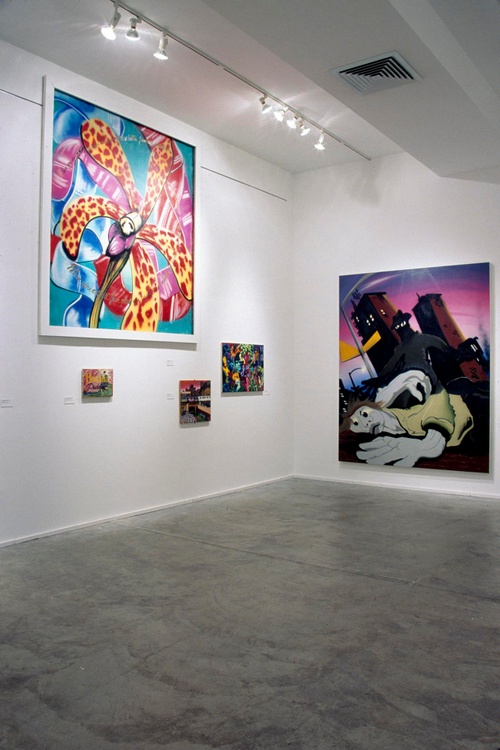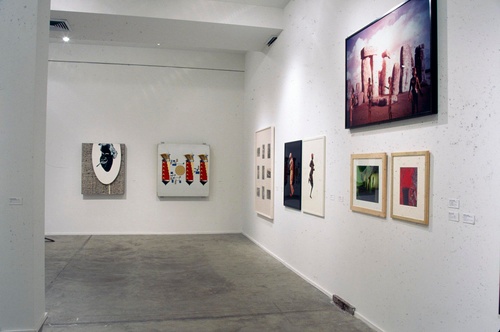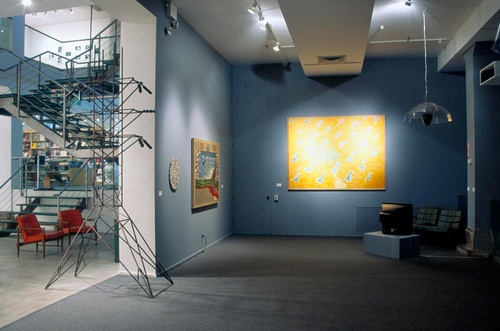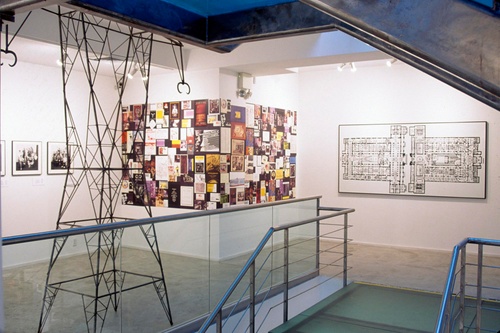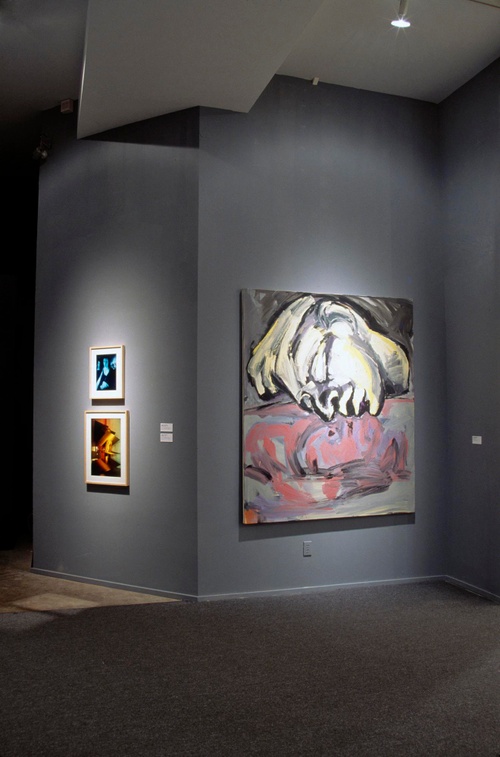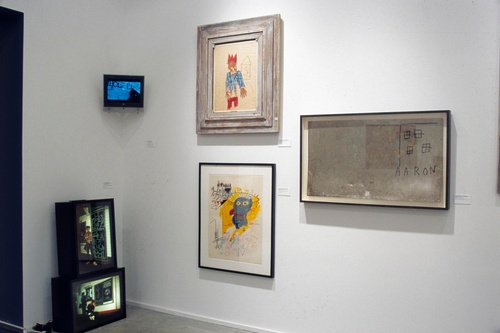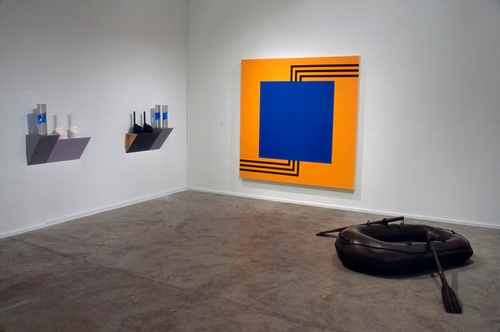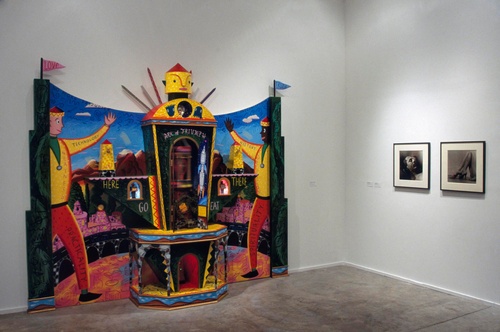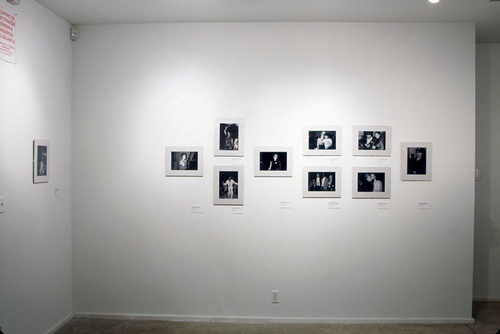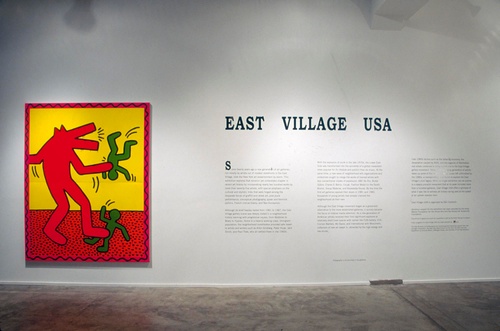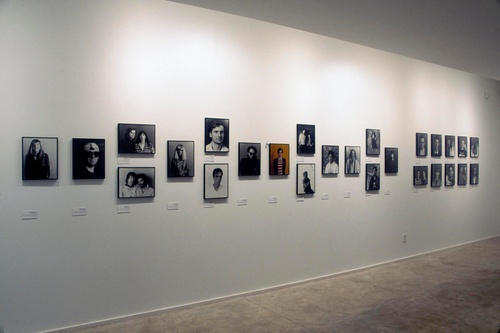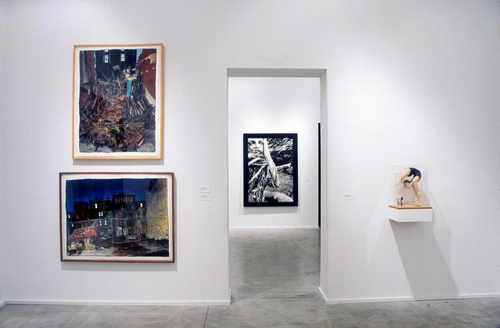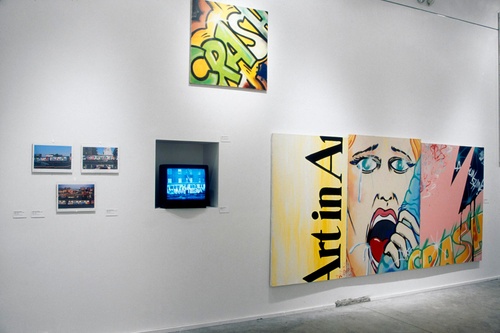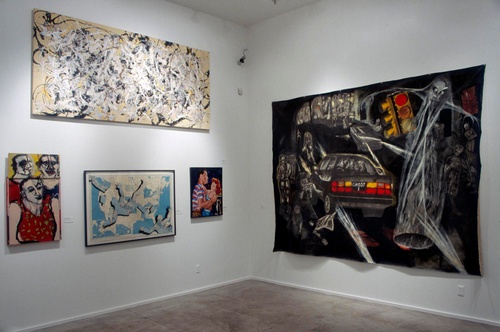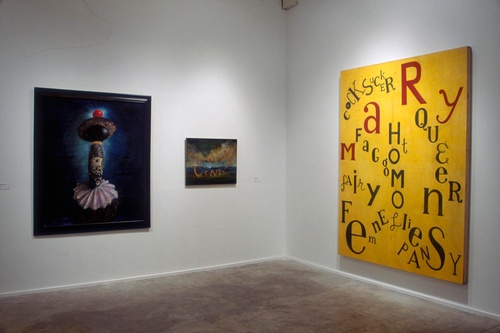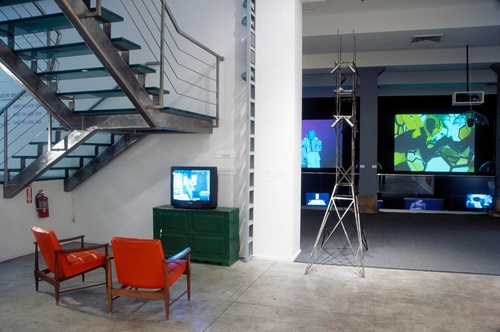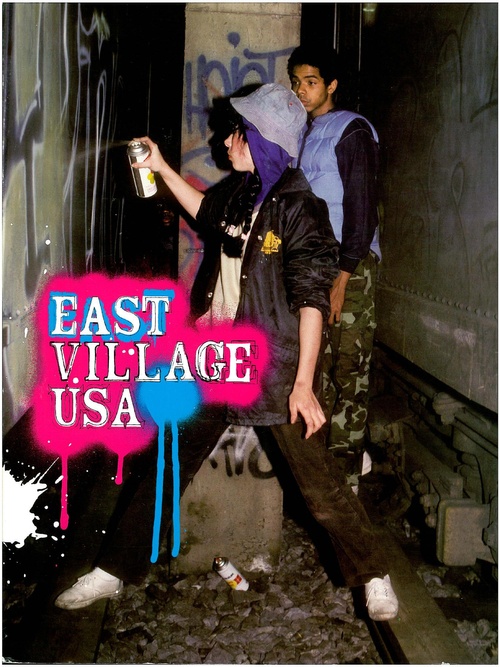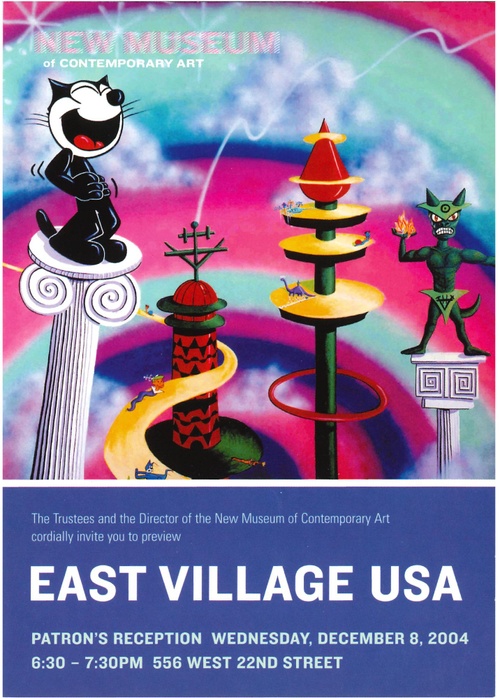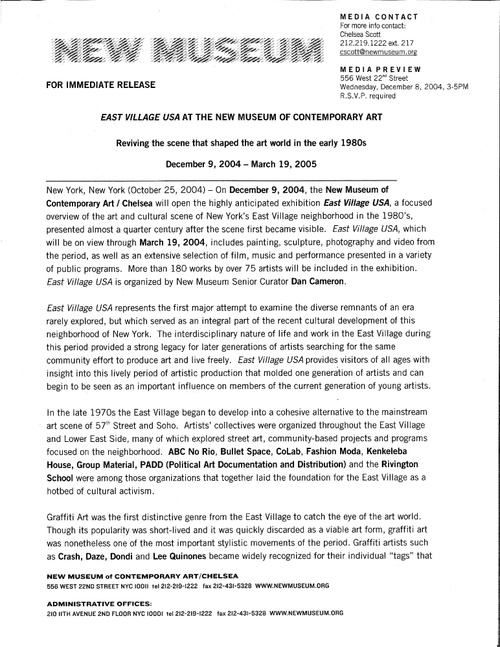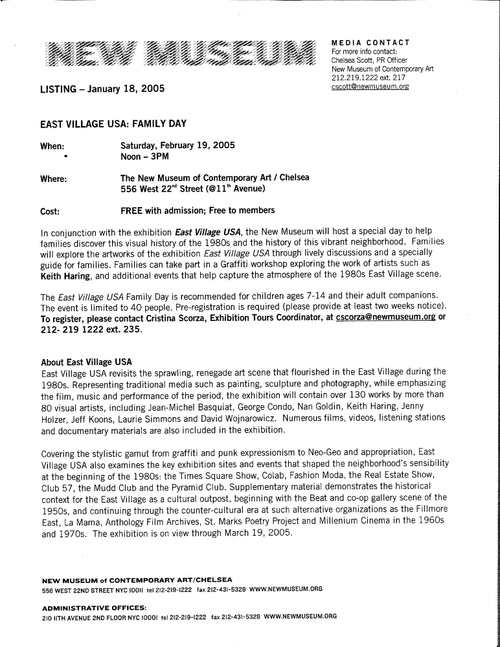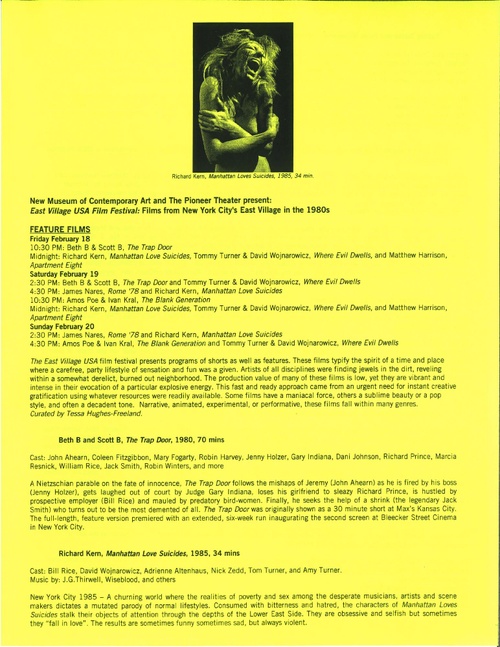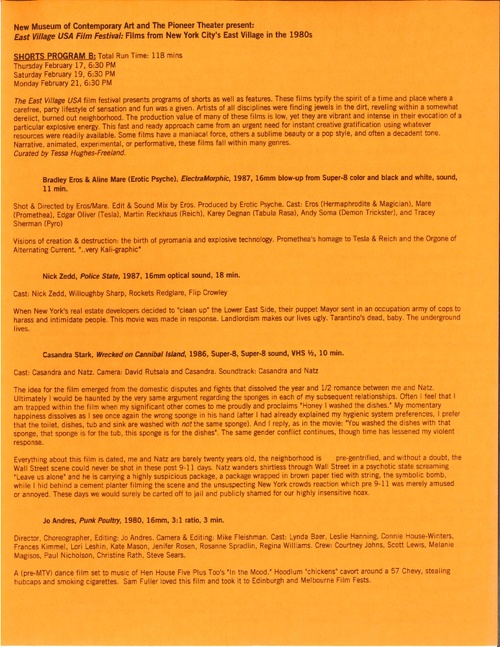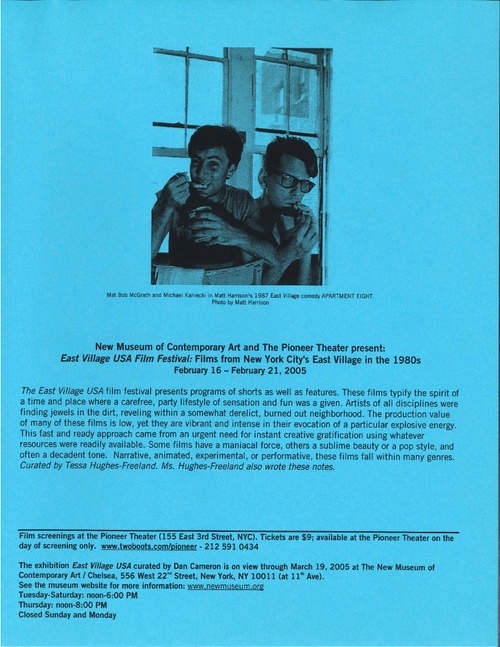East Village USA
East Village USA
Imagine a village where everybody is an artist, nobody has or needs a steady job, and anyone can be the art world’s Next Big Thing. Such was the myth (and occasionally the reality) of the East Village in the mid-1980s, when glamour and sleaze were nearly indistinguishable, and the boy next door was an androgynous, foot-high-peroxide-pompadour-sporting singer named John Sex. It was the height of the Reagan era, with its Cold War paranoia, intensified by growing nuclear fears, and inner cities and civic institutions in a state of increased upheaval and decay. Meanwhile, the East Village was busy inverting the values of trickle-down economics and gunboat diplomacy by transforming itself into the American dream’s dark underside, its evil twin, its inner child run amok.
Like many contested moments in recent cultural history, the beginnings and endings of the East Village art scene vary depending on whose point of view is being considered. There is, however, general consensus about three crucial factors that synchronized at the time and pulled all the other elements into place. The first was the Lower East Side’s long and charged history as a stronghold of radical bohemianism. The second was the sweeping appearance of neighborhood alternative spaces in the late 1970s, which drew many artists to the area. And the third was the rapid gestation of the hip-hop movement, beginning in the South Bronx during the mid-1970s and working its way downtown in the form of the predominantly graffiti-based FUN Gallery, which opened its doors in 1981 and was soon giving Jean-Michel Basquiat, Futura 2000, Keith Haring, and Kenny Scharf (among others) their first one-person gallery shows.
The largest body of work presented in East Village USA consists of paintings, sculptures, and photographs that were first presented in East Village galleries during the years 1981 through late 1987, by which point the galleries themselves (whose number had reached the low hundreds) began closing faster than they were opening. Although the East Village eventually became synonymous with a mid-1980s generation of colorful, funky, and often mock-Expressionist painters and sculptors, the more complicated reality is that the gallery scene was a hotbed of competing styles and attitudes that would eventually see the emergence of more deadpan, conceptually based artists such as Jeff Koons and Peter Halley as the logical antidote to an excess of glitter and gore.
The exhibition opens with pivotal early works by painters Kenny Scharf, Philip Taaffe, and Martin Wong, and makes a case for keeping such stylistic diversity at the forefront of our interpretation of the period. Scharf’s warped appropriations of Jetsons cartoon characters are in some ways the antithesis of Taaffe’s meticulous layering of images borrowed from Ellsworth Kelly and Bridget Riley; nevertheless, their shared use of cultural quotations links them to a broader 1980s project of emphatically refuting the myth of artistic originality. Wong’s African Temple at 9th Street reveals a completely different temperament, that of a self-taught artist enthralled by his adopted city and the vibrancy of even its most transient inhabitants.
The sequence of rooms in East Village USA follows a loose chronology, beginning with works by artists associated with the collaborative group CoLab and its watershed 1980 exhibition Times Square Show: Jane Dickson, Bobby G, Jenny Holzer, Becky Howland, Joseph Nechvatal, Tom Otterness, and Kiki Smith. The direct connection between these works and those of the graffiti generation represented by FUN Gallery, which is evident in the visual proximity of the examples shown here, reflects the shared sympathies felt at the time by the artists themselves. The exhibition encourages establishing a deeper link between the better-known Basquiat and Haring and artists such as Crash, Daze, Futura 2000, Lady Pink, Lee Quinones, and Zephyr, who all began their careers painting on subway trains and in so doing helped develop the potent fusion of public gesture, post-Pop sensibility, and semi-criminal status that became such a powerful lure to artists of the era. In viewing, in one place, a short film clip of Basquiat in his street role as SAMO, Quinones’s starkly violent painting Life Takes a Life, Lady Pink’s collaboration with Jenny Holzer, and Keily Jenkins’s gleefully satiric sculpture Home of the Brave, we are able to discern an urban reality whose complex inner workings are all the more compelling for being seen together for the first time since they were made.
The artists associated with Gracie Mansion Gallery were among the most dynamic of the period, and the gallery, one of the East Village’s first, soon became associated with a “New Romantic” style that embraced Rodney Alan Greenblat’s cartoon-inspired paintings and furniture-sculpture; Mike Bidlo’s direct appropriations from Pollock and Warhol; Stephen Lack’s droll views of American stereotypes; David Sandlin’s feverish visions of himself, his wife, and the Pulaski Skyway; and David Wojnarowicz’s epic retelling of his life story as the American dream gone wrong. A related group of artists, associated with galleries such as PPOW, explored a more socially engaged view of art, with Sue Coe merging as a key figure in the East Village’s early fusion of graphic art and painting, especially in her timely revamping of such early twentieth-century figures as Otto Dix.
The opening of Pat Hearn Gallery in 1984 signaled an important turning point in the East Village aesthetic. The cool, stripped-down paintings of Taaffe and Peter Schuyff, and the more Neo-Surrealist work of George Condo, evoked a stylistic sophistication that seemed to spurn some of the East Village’s proletarian trappings in favor of artworks and galleries that were every bit as polished as their uptown counterparts. Hearn, and later Massimo Audiello, also championed the work of artists such as photographer Jimmy de Sana, whose pictures referenced the rituals of bondage and S&M, and McDermott & McGough, whose collaborative paintings campily duplicated the modes of antique genres. By making a point of changing locations and artists as it suited her evolving vision, Hearn challenged the notion of the gallery roster as a statement of personal conviction in favor of a more fluid investigation into visual culture in the broader sense.
The last group of artists to successfully ride the East Village media wave of notoriety were those associated with International with Monument, especially Jeff Koons, Peter Halley, Ashley Bickerton, and the gallery’s co-owner Meyer Vaisman. Encompassing as well the more established photo-based artists Sarah Charlesworth, Richard Prince, and Laurie Simmons, the program at International with Monument combined with that at Nature Morte and other anti-angst galleries to signal that the Neo-Expressionist school of the 1980s had finally run its course; these artists saw themselves as successors to a photo-appropriation movement that had also developed in the late 1970s and early 1980s but had never been properly credited. Today one can see in Koons’s bronze life raft and Prince’s borrowed image of Brooke Shields traces of a more caustic discourse regarding the role of power and money in people’s everyday lives. Even in apparently more lighthearted works such as Simmons’s Tourism photographs, Peter Nagy’s absurd museum floor plan, and David Robbins’s head-shot photos of his contemporaries posed as would-be entertainers, it is clear that the guise of naïvité and childlike innocence had entirely lost its appeal.
The narrative of the East Village cannot be relayed without giving attention to the devastating role played by AIDS, in terms of both the work created at the time and in the neighborhood’s eventual demise as a gallery district. A room in East Village USA is devoted to conveying the rapid toll taken by the epidemic on many of the neighborhood’s local heroes, especially long-term East Village residents Jack Smith, Peter Hujar, and Paul Thek, for whom recognition came posthumously. Beginning with pop singer Klaus Nomi and writer/artist Nicolas Moufarrege, whose magazine articles had provided the East Village galleries their first media exposure, this section of the exhibition focuses both on more established artists such as Wojnarowicz, whose natural activist side was ignited by the crisis, and on those, including Arch Connelly, Luis Frangella, Greer Lankton, and Tseng Kwong Chi, whose art might be better known today had they survived their mid-thirties.
In the final analysis, the East Village was about much more than the artists and the galleries. It was also a nonstop party, a continual flow of outsized personalities, and an ever-unfolding treasure trove of performance. The last two sections of East Village USA examine, respectively, the legacy of East Village performance and the rich photographic documentation of the period-the who, what, where, and how much. In the Media Lounge and at various points throughout the exhibition, film and video are deployed to communicate the close tie that existed between visual and performing artists. From Glenn O'Brien’s late 1970s cable show TV Party and Charlie Ahearn’s pioneering rap, graffiti, and break-dancing film Wild Style to Richard Kern’s music video for Sonic Youth’s “Death Valley 69” and Nelson Sullivan’s video forays into the Pyramid Lounge, this section also provides an opportunity to revisit key works by an eclectic roster of artists, including Ethyl Eichelberger, John Epperson (Lypsinka), Karen Finley, John Jesurun, John Kelly, Ann Magnuson, Frank Maya, Frank Moore, Tom Rubnitz, Jim Self, and Fiona Templeton. The second-floor gallery explores the work of a diverse group of photographers who were part of the East Village scene. Dona Ann McAdams’s role as house photographer at P.S. 122 made her an insider at a vital moment in the evolution of performance, while Tom Warren’s unassuming manner enabled him to make portraits of hundreds of the period’s most memorable individuals. Timothy Greenfield-Sanders’s series depicting East Village gallerists, critics, and curators as The New Irascibles is already legendary, while Ande’ Whyland’s backstage views of early Wigstocks have rarely been seen. Patrick McMullan’s high-energy shots of club life help to evoke a departed era, while Hope Sandrow’s and Peter Hujar’s more introspective views consider the inner life of a few key individuals who have come and gone. These images, along with the off-site film program and the relatively casual presentations at different points in the exhibition of ephemera and graphic art connected to the East Village, attempt to make the case that the artistic richness of this era, which an exhibition of this scale can only begin to consider, encompasses a complete spectrum of cultural expressions, bringing it much closer to our own moment in time than we had ever imagined possible.

